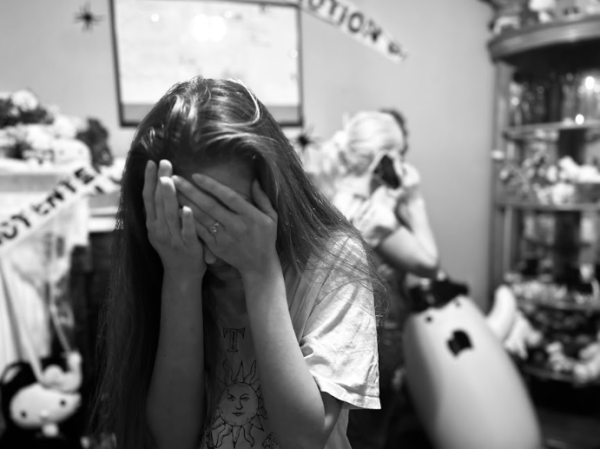Body shaming trend threatens positivity
Brianna Merila embraces herself by standing proudly.
October 12, 2016
Magazines today fill newsstands and grocery stores with headlines screaming,” Love yourself, lose 20 pounds in three days!”. “Get bikini body ready by this summer!” Their cover photos? Airbrushed models whose skin flawlessly glows, with strong prominent cheek and collar bones. Their audience: impressionable young children.
From a young age children are taught that if your body type doesn’t fit a certain standard they are “ugly” by societal standards. Junior, Kayla Chadwick said,”There’s just this range of I’m too small to fit society norms, and I’m too big to fit society norms.” She goes on to add, “As long as you’re healthy you don’t have to fit society norms.”
Chadwick, a dancer on Dance Company, said that she has dealt with having her body be shamed for being too thin. “ I was underweight when I was younger and I was always called a boy because I was very tall, lanky, [and] small. […] There was this one time that I was running and I wasn’t very fast and the teacher came up to me and said ‘Kayla you’re 30 pounds you should be running faster’ and I don’t see why that has to apply to my weight. […] It made me feel that I wasn’t as good, […] I had no say in it, like, I’m skinny so I have no issues. I’m skinny so my problems are less than others.”
Celeste Stratton, a senior also on Dance Company, also shared her experience with body shaming particularly because she’s a dancer.

Student holds up sign saying she’s beautiful in the way she is.
“[…] Ever since you’re little they tell you: here’s a dancer body and here’s what you need to be to fit the dancer body. You need to be the cookie cutter image, you know? You have to be skinny, really tall, really pretty with all your limbs and it’s really hard when you don’t fit that stereotype.” stated Stratton.
A study conducted by the National Eating Disorders Association (NEDA) found that 70% of children ages 6 to 12 wanted to be thinner. Another study by the National Association of Anorexia Nervosa and Associated Disorders showed that 69% of girls in 5th – 12th grades reported that magazine pictures influenced their idea of a perfect body shape.
While young teen girls are statistically more likely to suffer from eating disorders and low self-esteem, teenage boys are also held to unrealistic expectations and suffer just the same.
Disorders like anorexia, bulimia, and overeating are diseases that boys can suffer from, but there is one in particular that boys tend to suffer from more. Muscle Dysmorphia, a.k.a reverse anorexia, is when a person who has a low self-esteem desires to “bulk-up” and gain muscle mass at an alarming and unhealthy rate. Though this condition can occur in anyone, it is especially relevant amongst boys.
Many advertisements for “getting the best body” and what a “normal” body should look like are spawned from pop culture and advertised to today’s youth.
“A little kid sees that this person is ‘this way’, it’s going to influence them and they will have those insecurities from a young age. Nowadays its just getting thrown at you all over the place from social media and magazines and stuff like that. It’s getting younger and younger, now all guys have to go to the gym and get buff, that’s not what it should be about it should be about being a kid.” said Junior Adam Vanderlinden.
Vanderlinden has noticed in today’s society the growing concern amongst children about the way they look. It has also been noted how the “ideal” body type is marketed to kids and Vanderlinden believes that everyone should be more okay with their body, they shouldn’t feel so pressured to look a certain way. “They should love each other, everyone has hard times especially in high school, everyone is just trying to fit in.”





